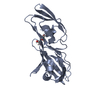+Search query
-Structure paper
| Title | An unbroken network of interactions connecting flagellin domains is required for motility in viscous environments. |
|---|---|
| Journal, issue, pages | PLoS Pathog, Vol. 19, Issue 5, Page e1010979, Year 2023 |
| Publish date | May 30, 2023 |
 Authors Authors | Marko Nedeljković / Mark A B Kreutzberger / Sandra Postel / Daniel Bonsor / Yingying Xing / Neil Jacob / William J Schuler / Edward H Egelman / Eric J Sundberg /   |
| PubMed Abstract | In its simplest form, bacterial flagellar filaments are composed of flagellin proteins with just two helical inner domains, which together comprise the filament core. Although this minimal filament ...In its simplest form, bacterial flagellar filaments are composed of flagellin proteins with just two helical inner domains, which together comprise the filament core. Although this minimal filament is sufficient to provide motility in many flagellated bacteria, most bacteria produce flagella composed of flagellin proteins with one or more outer domains arranged in a variety of supramolecular architectures radiating from the inner core. Flagellin outer domains are known to be involved in adhesion, proteolysis and immune evasion but have not been thought to be required for motility. Here we show that in the Pseudomonas aeruginosa PAO1 strain, a bacterium that forms a ridged filament with a dimerization of its flagellin outer domains, motility is categorically dependent on these flagellin outer domains. Moreover, a comprehensive network of intermolecular interactions connecting the inner domains to the outer domains, the outer domains to one another, and the outer domains back to the inner domain filament core, is required for motility. This inter-domain connectivity confers PAO1 flagella with increased stability, essential for its motility in viscous environments. Additionally, we find that such ridged flagellar filaments are not unique to Pseudomonas but are, instead, present throughout diverse bacterial phyla. |
 External links External links |  PLoS Pathog / PLoS Pathog /  PubMed:37253071 / PubMed:37253071 /  PubMed Central PubMed Central |
| Methods | EM (single particle) / X-ray diffraction |
| Resolution | 1.475 - 4.2 Å |
| Structure data | EMDB-40765, PDB-8sug:  PDB-8erm: |
| Chemicals |  ChemComp-GOL:  ChemComp-SO4:  ChemComp-HOH: |
| Source |
|
 Keywords Keywords |  CELL ADHESION / CELL ADHESION /  Flagellin / Flagellin /  motility / motility /  bacteria / bacteria /  flagella / flagella /  STRUCTURAL PROTEIN / STRUCTURAL PROTEIN /  PROTEIN FILAMENT / Bacterial flagellar filament / PROTEIN FILAMENT / Bacterial flagellar filament /  Pseudomonas Pseudomonas |
 Movie
Movie Controller
Controller Structure viewers
Structure viewers About Yorodumi Papers
About Yorodumi Papers






